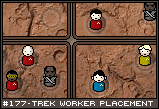| Three Hundred |
| - Index Page |
| - About... |
| - By Year |
| Collections |
| - Comp-Grid |
| - Procedural |
| - Tactics |
| - Tiny Crawl |
| - Misc |
| Previous | Mechanic #177 | Next |
![[trek1.png]](set09/img/entry177-trek1.png)
This is a cross between an adventure game and a worker placement game. Basically, place your crew members at certain locations to earn resources, then use your crew members' abilities and resources to solve "puzzles" and advance the episode plot.
Your basic "pieces" in the game are pawns representing crew members of the Enterprise. Crew members come in three types: Cast, Guest Stars, and Ensigns. Ensigns are your typical nameless, faceless crew members (the redshirts, if you will), while the Cast are more permanent fixtures that are more capable. Guest Stars are special temporary Cast members that are specific to the adventure at hand. In addition to this, they belong to one of three disciplines: science, security, and command. These represent the basic class of the crew member. For instance, in Sick Bar, only Science personnel gain resources when placed. Finally, each crew member has a number of named abilities, like Astrophysics, Navigation, Diplomacy, Tactics, etc. Ensigns only have one ability, limited to their discipline, while Cast and Guest Stars can have multiple abilities. These keywords represent a talent and are sometimes required to score resources.
The world is broken into rooms, and each room into resource spots where you can place your crew members. When I use the term "resources", I don't just mean physical resources. While it can be things like medical supplies or weapons, it can also mean things like knowledge, morale, or reputation.
![[trek2.png]](set09/img/entry177-trek2.png)
Each resource spot has a list of resources that you can get, going from specific to more general. Placing a crew member on that spot will gain the resources that it most specifically meets the requirements to. In this example, any science discipline crew member on the spot will earn "Medical Experience" resources each turn, while a science crew member with the "Medic" ability will earn "Medical Experience" and a physical medkit resource. Additionally, there are resource trades that require actions to perform. Rather than gaining resources, these trade resources of one type for another. In this example, a science crew member with a "Medical Experience" resource can choose to spend that resource in exchange for the ship gaining a new science Ensign. (That's a nonsensical example, but you get the point). There are three different types of resources: Personal, gained by each individual crew member, Ship, used by the ship to perform actions, and Adventure, which represents progress made in the current adventure. In specific rooms on the Enterprise, personal resources can be traded for Ship resources. Operations crew members in the Engine Room can earn engineering knowledge and computer cycles that can be traded in for Ship Basic Energy units (used to operate the transporter), Ship Shield Energy (used to power the shield), and Ship Photon Torpedo resources. These Ship resources are dependent on person resources gained in the Engineering rooms, crew abilities, and which station each crew member is stationed at.
![[trek3.png]](set09/img/entry177-trek3.png)
The non-Enterprise section is set up similar to the Desktop Adventure games, or more specifically, [#159 - PGC: Puzzle Tree Building]. That is, there is a randomly generated map of rooms that is built in a specific manner to create a playable adventure puzzle tree.
![[trek4.png]](set09/img/entry177-trek4.png)
The difference here is that the "puzzles" in the puzzle tree aren't really puzzles. They are resource exchanges. You can look at the above tree as either a puzzle tree, or a resource dependency chart, like you might see in MMORPG crafting. You progress through the tree, and through the story, by gaining the appropriate resources and trading them to other resources. An example. Before you can enter the Ice Cave, you must get permission from the tribe Elder. However, the Elder won't talk to you yet. So you go around the the Forest where the tribe has huts. By placing Ensigns in the resource spots next to tribe NPCs, you can earn "Diplomacy" resources that can be traded in for Adventure resources representing Away Team reputation amongst the tribe. Once you have enough adventure reputation resource, you can take the Captain to the Elder and trade them in for an Adventure "Cave Permission" resource. Adventure "puzzles" are nothing more than resource trades, though they may come with dialogue and cutscenes to flesh out the story. The challenge of the game really comes from finding the best route to get the resources you need, while also fighting Klingons in space and on the planet surfaces (Ensigns are lost, while Crew get shipped to the Sick Bay where resources are gained and spent to heal them up). It's all resources, all the time, but framed through a puzzle tree rather than crafting.
- My main inspiration here comes from the Star Trek CCG. In it, you have crew members with abilities which you use to overcome dilemmas and win planets. However, in that game, it's very anticlimactic, as the abilities work as simple locks (do I have the prereqs or not?), which a large part of the gameplay coming from unpredictable Dilemma cards and the randomness of card draws. I loved the idea, but the implementation needed work. - I don't play Worker Placement board games, so I may be using the term incorrectly. This idea was actually my attempt to put something I don't like or understand - namely, resource management - and put it into a framework that I do like and understand. I know that crafting in MMOs, from gathering resources to building components to minmaxing quality, can be addictive to a certain sort of people. Why not use it for something other than making potions and swords?
|
